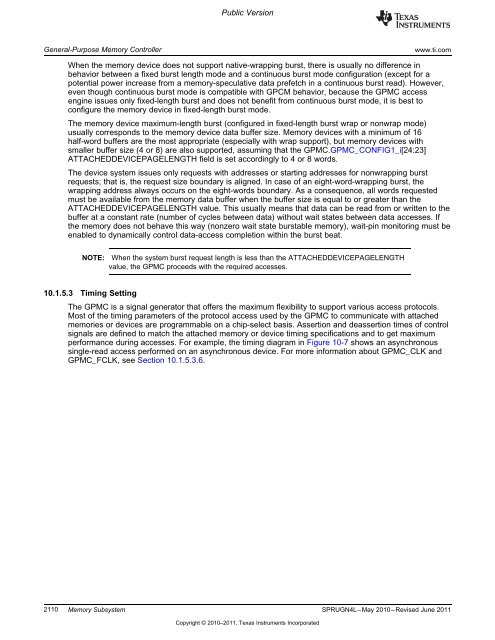Chapter 10 Memory Subsystem.pdf
Chapter 10 Memory Subsystem.pdf
Chapter 10 Memory Subsystem.pdf
Create successful ePaper yourself
Turn your PDF publications into a flip-book with our unique Google optimized e-Paper software.
Public Version<br />
General-Purpose <strong>Memory</strong> Controller www.ti.com<br />
When the memory device does not support native-wrapping burst, there is usually no difference in<br />
behavior between a fixed burst length mode and a continuous burst mode configuration (except for a<br />
potential power increase from a memory-speculative data prefetch in a continuous burst read). However,<br />
even though continuous burst mode is compatible with GPCM behavior, because the GPMC access<br />
engine issues only fixed-length burst and does not benefit from continuous burst mode, it is best to<br />
configure the memory device in fixed-length burst mode.<br />
The memory device maximum-length burst (configured in fixed-length burst wrap or nonwrap mode)<br />
usually corresponds to the memory device data buffer size. <strong>Memory</strong> devices with a minimum of 16<br />
half-word buffers are the most appropriate (especially with wrap support), but memory devices with<br />
smaller buffer size (4 or 8) are also supported, assuming that the GPMC.GPMC_CONFIG1_i[24:23]<br />
ATTACHEDDEVICEPAGELENGTH field is set accordingly to 4 or 8 words.<br />
The device system issues only requests with addresses or starting addresses for nonwrapping burst<br />
requests; that is, the request size boundary is aligned. In case of an eight-word-wrapping burst, the<br />
wrapping address always occurs on the eight-words boundary. As a consequence, all words requested<br />
must be available from the memory data buffer when the buffer size is equal to or greater than the<br />
ATTACHEDDEVICEPAGELENGTH value. This usually means that data can be read from or written to the<br />
buffer at a constant rate (number of cycles between data) without wait states between data accesses. If<br />
the memory does not behave this way (nonzero wait state burstable memory), wait-pin monitoring must be<br />
enabled to dynamically control data-access completion within the burst beat.<br />
NOTE: When the system burst request length is less than the ATTACHEDDEVICEPAGELENGTH<br />
value, the GPMC proceeds with the required accesses.<br />
<strong>10</strong>.1.5.3 Timing Setting<br />
The GPMC is a signal generator that offers the maximum flexibility to support various access protocols.<br />
Most of the timing parameters of the protocol access used by the GPMC to communicate with attached<br />
memories or devices are programmable on a chip-select basis. Assertion and deassertion times of control<br />
signals are defined to match the attached memory or device timing specifications and to get maximum<br />
performance during accesses. For example, the timing diagram in Figure <strong>10</strong>-7 shows an asynchronous<br />
single-read access performed on an asynchronous device. For more information about GPMC_CLK and<br />
GPMC_FCLK, see Section <strong>10</strong>.1.5.3.6.<br />
21<strong>10</strong> <strong>Memory</strong> <strong>Subsystem</strong> SPRUGN4L–May 20<strong>10</strong>–Revised June 2011<br />
Copyright © 20<strong>10</strong>–2011, Texas Instruments Incorporated

















